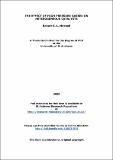Files in this item
The effect of high pressure gasses on heterogeneous catalysts
Item metadata
| dc.contributor.advisor | Cole-Hamilton, D. J. (David John) | |
| dc.contributor.author | Mitchell, Robert G. L. | |
| dc.coverage.spatial | 172 | en_US |
| dc.date.accessioned | 2010-07-02T10:50:39Z | |
| dc.date.available | 2010-07-02T10:50:39Z | |
| dc.date.issued | 2009 | |
| dc.identifier | uk.bl.ethos.552333 | |
| dc.identifier.uri | https://hdl.handle.net/10023/955 | |
| dc.description.abstract | Several heterogeneously catalysed reactions have been studied at pressures above and below the critical pressure of carbon dioxide in both carbon dioxide and nitrogen. The purpose of this study was to ascertain if carbon dioxide above its critical pressure and temperature would have a beneficial effect on the active life time of the catalysts When the Beckmann rearrangement of cyclohexanone oxime was studied it was discovered that using carbon dioxide above its critical pressure and temperature was beneficial to catalyst lifetime at both 250°C and 300°C, however the beneficial effect was also observed in nitrogen under the same conditions. It is proposed that the benefits at higher pressures are due to an increased residence time in the reactor or increased competition for active sites. When the process was performed at 380°C, a previously unreported impurity was observed in the collected samples. This was shown to be N-ethyl caprolactam, it is proposed that this is formed by a Ritter style reaction with 5-cyanopent-1-ene known to be formed during the reaction When the Fries rearrangement of phenyl acetate was studied it was discovered that increasing reactor pressure appeared to have little or no effect on the catalyst; it is thought this is because the reaction temperature of 150°C is below the boiling point of phenyl acetate, and that the reaction being observed occurs purely in the liquid phase. When the Diels-Alder addition of isoprene to methyl acrylate was studied, it was discovered that using carbon dioxide above its critical pressure had the effect of improving catalyst lifetime and conversion to desired product, with the greatest effect being at 50 bar. It was discovered that using nitrogen under the same conditions led to a greater improvement in conversion and catalyst lifetime. It is thought that the reactions in carbon dioxide are in a near critical state at 50 bar leading to the maximum effect at this pressure, and at higher pressures the reactions are bi- or multi-phasic, leading to the decrease in the effect. In the process of studying the above reactions an effective rig for the study of high pressure heterogeneously catalysed reactions was built. | en_US |
| dc.language.iso | en | en_US |
| dc.publisher | University of St Andrews | |
| dc.subject.lcc | QD281.C3M58 | |
| dc.subject.lcsh | Carbon dioxide | en_US |
| dc.subject.lcsh | Nitrogen | en_US |
| dc.subject.lcsh | Heterogeneous catalysis | en_US |
| dc.subject.lcsh | Catalysts | en_US |
| dc.title | The effect of high pressure gasses on heterogeneous catalysts | en_US |
| dc.type | Thesis | en_US |
| dc.type.qualificationlevel | Doctoral | en_US |
| dc.type.qualificationname | PhD Doctor of Philosophy | en_US |
| dc.publisher.institution | The University of St Andrews | en_US |
This item appears in the following Collection(s)
Items in the St Andrews Research Repository are protected by copyright, with all rights reserved, unless otherwise indicated.

